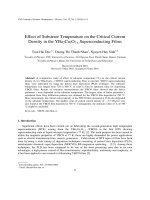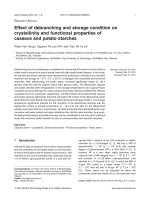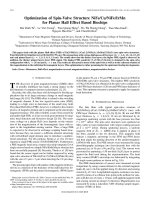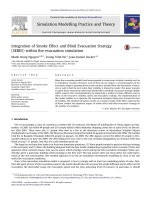DSpace at VNU: Effect of Finite State AMC on the practicality of dual feedback bandwidth request control
Bạn đang xem bản rút gọn của tài liệu. Xem và tải ngay bản đầy đủ của tài liệu tại đây (279.02 KB, 5 trang )
2010 International Conference on Cyber-Enabled Distributed Computing and Knowledge Discovery
Effect of Finite State AMC on the Practicality of
Dual Feedback Bandwidth Request Control
Nguyen Quoc Tuan
University of Engineering and Technology, Vietnam
National University, Hanoi
Dinh-Thong Nguyen, Member IEEE
Faculty of Engineering and Information Technology,
University of Technology, Sydney
Abstract- Dual feedback control algorithm has proved to
allow the base station to respond quickly and efficiently to
the uplink bandwidth request in broadband wireless access
(BWA) networks [2][3]. In this algorithm the bandwidth
request is calculated based on both the length of the
backlogged queue and the mismatch between packet
arrival and service rates. However, the physical channel
quality, SNR, does not play any role in the algorithm;
therefore the algorithm is suboptimal with respect to
bandwidth utilization. Under fading conditions modern
BWA networks employ adaptive modulation and coding
(AMC) which has only a finite number of discrete service
rates to grant to subscribers. In this paper, we examine the
effect of AMC in WiMAX using the Finite State Markov
Channel model on the practicality and efficiency of the
dual feedback bandwidth request control algorithm.
I.
Traditional bandwidth scheduling algorithms in multi-users
wireless networks are based solely on the user’s physical
channel quality in terms of signal-to noise ratio (SNR). This
often results in a significant mismatch between the packet
arrival rate at the SS and the rate at which its packets are being
serviced by the network, i.e. being transmitted, hence creating
either a backlog in the queue at the SS which is undesirable
for the SS, or an empty queue which is undesirable for
network bandwidth efficiency. However the response to a
bandwidth request based on information about the backlogged
queue length alone suffers from the usual feedback delay in
the time-division duplex (TDD) mode of transmission between
the BS and the SSs. Because of this, a group of researchers at
Samsung Electronics has recently proposed a bandwidth
request-allocation control algorithm for real-time services [2]
based on dual feedback of information from both rate
mismatch and queue length mismatch which is a measure of
queue length deviation from a desired length to keep the delay
to within the QoS requirement. The main virtue of dual
feedback algorithm is that the SS uses the rate mismatch as a
predictive indicator on the queue length variation in order to
calculate the next bandwidth request, thus enhancing the
reliability of the request. The algorithm requires the SS to be
more proactive and to cooperate with the BS in working out
together a more efficient bandwidth request.
INTRODUCTION
The central challenging task in design and operation of a
multi-users broadband wireless access (BWA) network is to
come up with a fair and efficient scheduling of the network’s
finite bandwidth to users of different types of traffic,
satisfying the agreed QoS requirements. In order to support
QoS for various types of traffic, IEEE 802.16 (commonly
known as WiMAX) medium access control (MAC) protocol
[1] defines bandwidth request-allocation mechanisms for five
types of scheduling classes: Unsolicited Grant Service (UGS)
being suitable for constant bit rate services such as VoIP, realtime Polling Service (rtPS) being suitable for variable bit rate
traffic such as MPEG video, extended real-time Polling
Service (ertPS) as a compromise for delay sensitivity and
bandwidth efficiency, non-real-time Polling Service (nrtPS),
and Best-Effort (BE). The above are the general scheduling
mechanisms that the base station (BS) uses to allocate
bandwidth to subscriber stations (SS), but the detailed
algorithm to decide how much bandwidth is allocated to a
request is not standardized but is left to the innovation of
proprietary implementations by equipment vendors and/or
network operators.
978-0-7695-4235-5/10 $26.00 © 2010 IEEE
DOI 10.1109/CyberC.2010.69
The suboptimal nature of the dual feedback bandwidth
request control algorithm proposed in [2] is that the physical
channel quality, i.e. the SNR, does not play any role in the
algorithm. In modern BWA networks, adaptive modulation
and coding (AMC) is used by the BS to assign a certain
modulation and coding scheme to the SS in accordance with
the SNR of the SS’s link in order to optimize the system’s
bandwidth efficiency, hence its throughput. The WiMAX
fading channel is modeled using a Finite State Markov
Channel (FSMC) model [5] corresponding to the finite
number of combination of modulation and coding schemes
recommended in the 802.16 standards. Thus the BS operates
only with a finite number of discrete optimal spectral
efficiencies c(n). If the granted bandwidth BW is fixed such as
352
where l (bytes) is the average packet size and T0 represents
any additional delay apart from queuing delay.
in the UGS scheduling, service rates s(n)=BW*c(n), being
available for allocation to the SSs will also be of finite step
changes, and these rates often do not match those calculated
from the dual feedback algorithm under the optimistic
assumption that the BS can, most of the time, satisfy the
bandwidth requests. Thus the granted bandwidth can only be
time varying, b(n), and the reserved bandwidth agreed on
admission can only be based on the statistical average of b(n).
This is only an example in which the above dual feedback
algorithm is not practical for UGS implementation. From our
experience, b(n) can become quite large that even ertPS
scheduling cannot practically satisfy the request. It is
important to realize that the fixed system radio resource that
BS has the job to schedule to the SSs is the system bandwidth
in Hz, not the service rates.
Let Q(n) be the queue length, a(n) and s(n) be the packet
arrival rate (to the wireless channel) and the packet departure
rate (from the channel), i.e. service rate by the channel,
respectively, at time instant nTa; the total bandwidth request
at time nTa be B(n) and the additional request be ΔB(n); then
in a dual feedback system ΔB(n) has two components: one
deduced from the queue length mismatch eq(n)=q(n)-Qref and
the other from the transmission rate mismatch er(n)=a(n)-s(n),
i.e. ΔB( n ) = K q e q ( n ) + K e r ( n ) where Kq and Kr are
r
constants [2]
By observing that the unit of eq(n) is in byte while that of
er(n) is in byte per second, we can see that Kr in ∆B(n) above
is not a constant but has a unit of time depending on service
interval Ta. We therefore have proposed in to modify the
algorithm to [3]
In [5] we have already examined this issue and have proved
that the stability condition given for the continuous-time
transfer function cannot guarantee the stability of its discretetime implementation of the algorithm.
In this paper, we
propose a simple technique to calculate the reserved
bandwidth for a given arrival traffic under a given channel
fading condition. Obviously, the technique is most suitable for
exrtPS to update its bandwidth request. Fortunately, the
proposed calculated reserved bandwidth is near optimal in
terms of PHY and MAC layers, and furthermore it is
independent of the proposed dual feedback algorithm in [2].
ΔB ( n) = K q e q ( n) + C r Ta e r ( n )
It is obvious that rate mismatch directly creates fluctuation
in the queue length q(n), hence a fluctuation in the queue
length mismatch eq(n), i.e.
er ( n ) = a ( n) − s ( n )
The rest of the paper is organized as follows: Section II
presents a summary of the bandwidth request control
algorithm based on dual feedback, including its stability in the
discrete-time (implementation) domain. In Section III, a brief
explanation of the 10-state Finite State Markov Channel
model proposed for WiMAX in [5] is given. Section IV
presents the simulation setup and results. The paper ends with
a brief conclusion in Section V.
II.
=
Ta
l
T
a
[ q ( n) − q ( n − 1)] =
1
[e ( n) − e ( n − 1)]
q
q
T
a
(3)
Under strict admission control and priority scheduling for
real-time traffic, the authors in [2] assume that the BS can
mostly satisfy bandwidth request for real-time services by
allocating bandwidth at a rate more or less equal to the
bandwidth requested by the SS on average,
In this section we present a summary of the dual feedback
algorithm in discrete-time domain for bandwidth request
control proposed in [2]. Discrete-time implementation of
hardware and software is the ultimate objective of modern
electronic and telecommunication systems. Therefore the
stability of any control algorithm depends ultimately on its
system transfer function G(z) in the z-domain. The algorithm
assumes that the bandwidth allocation interval Ta (sec) is equal
to the packetization interval of the real time service, which is
constant. The relationship between the tolerable MAC-toMAC target delay, Tref, of the service and the corresponding
target transmission queue length, Qref (bytes), is
Qref =
1
The relationship in (3) is the essence of the dual feedback
algorithm.
DUAL FEEDBACK ALGORITHM FOR UPLINK
BANDWIDTH REQUEST
Tref − T0
(2)
s(n) ≈ α
B ( n − 1)
(4)
Ta
As we have mentioned in the Introduction, this assumption is
neither realistic in a heavily subscribed network, nor practical
in a modern network in which adaptive modulation and coding
is used in fading environment. As will be seen later on in this
section, α plays an important role in the stability of the system,
yet in [2] it is simply assumed to be 1.
Taking z-transform of (3) and (4) then combining them, we
have
(1)
A( z ) − α
353
z −1 B ( z ) 1 − z −1
Eq ( z )
=
Ta
Ta
(5)
From the z-transform of (2) and (3), we have
ΔB( z) = B( z)(1 − z −1 )
= Kq Eq ( z) + Cr Eq ( z).(1 − z −1 )
algorithm is that the physical channel quality, i.e. the SNR,
does not play any role in the algorithm. Yet in modern BWA
networks, adaptive modulation and coding (AMC) is used by
the BS to assign an appropriate modulation and coding scheme
to the SS in accordance with the SNR of the SS’s link in order
to optimize the system’s bandwidth efficiency, hence its
throughput. As has been discussed in the Introduction, to
apply the dual feedback algorithm for calculating the granted
service rate s(n), the corresponding granted bandwidth b(n)
has to be a function of time.
(6)
Replacing B(z) in (5) using (6) gives us the resulting
discrete-time transfer function of the dual feedback
mechanism
G( z) =
Eq ( z )
A( z )
1 − z −1
= Ta − 2
z (1 − αCr ) + (αK q + αCr − 2) z −1 + 1
(7)
The stability of the discrete-time system in (7) requires
that poles of G(z) are located within the unit circle. It can be
easily verified that this requirement is satisfied if
0< αCr <1.
(8)
III. EFFECT OF FINITE STATE AMC MODEL ON
DUAL FEEDBACK BANDWIDTH REQUEST CONTROL
In [1] repetition coding is recommended in Mobile WiMAX
as a useful technique to overcome deep fading. In repetition
coding, the same symbol is transmitted on several different
subcarriers so that if the information on one of those
subcarriers is corrupted, the information on other subcarriers
will be received correctly by a maximum ratio combining
(MRC) receiver. In [4], the system spectral efficiency, c
bps/Hz, is maximized under Rayleigh fading condition by
applying power control to the instantaneous SNR and by
taking into account both the convolutional coding gain and the
repetition coding gain. Thus for a given value of the SNR γ of
the wireless channel, the AMC algorithm in the BS will decide
which PQSK or M-QAM and coding rate, and what associated
transmit power to best use on the channel . The maximization
provides the boundaries of the SNR partition for the 10-state
FSMC model, corresponding to 10 AMC schemes available in
mobile WiMAX [1], as illustrated in Figure 1 for the Rayleigh
fading condition having an average SNR of γ =5dB . It is
clear from Table 1 that repetition coding allows the WiMAX
system to extend its operating range to very poor fading
conditions of worse than -4dB with 6x-repetition coding on
the most robust modulation scheme.
Figure 1. SNR partition for 10-state (with repetition coding) and 7-state
(without repetition coding) FSMC model for mobile WiMAX
In a Rayleigh fading environment, the spectral efficiency c(n)
is determined by the instantaneous SNR γ(n) through the 10state FSMC model.
Let
a=
1
N
N
∑ a ( n)
(9)
n =1
be the average arrival rate in bps, and
c=
1
N
N
∑ c ( n)
(10)
n =1
be the average spectral efficiency in bps/Hz.
c(n) is obtained by looking up the 10-state FSMC model for
the instantaneous SNR γ(n) of the fading distribution.
The agreed admission bandwidth (agreed by the BS before
transmission) can be calculated as
BWadm =
Recall that the main virtue of dual feedback algorithm in [2]
is that the SS uses the rate mismatch in (3) as a predictive
indicator on the queue length variation in order to calculate the
next bandwidth request, thus enhancing the reliability of the
request.
The obvious weakness of the dual feedback
354
1 N a ( n)
∑
N n =1 c(n)
in Hz
(11)
So, it is a function of both the Rayleigh fading γ dB, a
Physical layer parameter, and the arrival traffic, a MAC layer
quantity.
The granted service rate s(n) calculated according to the dual
feedback bandwidth request control algorithm, is
s ( n) = α
B(n − 1)
Ta
(12)
The granted bandwidth at time n is
b ( n) =
s ( n)
c ( n)
(13)
The average granted service bandwidth over the observed
period of N arrival times is therefore
BWser =
1
N
N
∑ b ( n)
Figure 2. Histogram of spectral efficiency c(n) for 6dB average SNR
channel. Service rate s(n)= c(n)*BW.
(14)
n =1
This BWser is also a function of both γ , a Physical layer
parameter, and s(n), a MAC layer quantity.
and Cr=Kr/Ta= 0.25 corresponding to a stable situation [2][3].
Yet it can be seen from the Table that when the fading is
bad ( γ =2dB), the average service bandwidth, BWser, exceeds
the agreed admission bandwidth, BWadm. Similarly, a close
look at the variation of the instantaneous granted/service
bandwidth in Figure 3 reveals that during a bad fading period
it often far exceeds the average value. Therefore, it is not
practical for the BS to agree on a reserved admission
bandwidth for UGS scheduling mechanism. In Figure 3, the
instantaneous bandwidth request is seen often to grow more
than tenfold the average agreed admission bandwidth. Similar
observation is noted with the ertPS mechanism.
It is obvious that the system queue will build up and overflow
or not depending on the relationship between BWadm and
BWser.
IV.
SIMULATION SET-UP AND RESULT
In this paper we are interested only in the effect of finite
state AMC on the suitability and efficiency of the dual
feedback bandwidth request control algorithm proposed in [2].
We simulate a scenario of independent incoming subscribers,
where the traffic a(n) of each has fixed packet arrival time of
Ta=20ms and exponentially distributed packet length with an
average of 500bytes giving an average of 217.20 Kbps arrival
rate. The scheduling mechanisms used in this simulation are
UGS and ertPS. The queue size is 64 KBytes and the targeted
queue length Qref=5 Kbytes corresponding to a target delay of
200ms. The bandwidth request is limited to Bmin=2 bytes and
Bmax=1 Kbytes. Packets will be dropped on overflow.
TABLE I.
KQ=0.2, CR=0.25
Av. SNR γ
Av. c bps/Hz
BWadm KHz
BWser ertPS KHz
BWser UGS KHz
In Figure 2 below, we can see that for the channel quality
of 6dB SNR, the finite state AMC assigns the channel to
mainly the 16-QAM R3/4 (3bps/Hz) and 16-QAM R1/2
(2bps/Hz) modulation and coding schemes (see Table II). The
corresponding agreed average admission bandwidth is found
from (11) to be 147.91 KHz.
V.
2dB
6dB
1.50
189.81
190.74
191.29
2.16
147.91
135.22
136.37
CONCLUSION
We have demonstrated in this paper that the dual feedback
bandwidth request control algorithm originally proposed in [2]
is not practical for implementation in wireless systems where
adaptive modulation and coding is employed. The algorithm
and its stability has been developed basically for continuous
systems in which bandwidth request is a well behaved
continuous variable, while in modern broadband wireless
systems the granted bandwidth involves step-change. This
makes the algorithm impractical, or at least inefficient for use
with UGS and ertPS scheduling mechanisms.
Table I is a summary of the simulation results of the
average agreed admission bandwidth and the average
granted/service bandwidth for three channel fading conditions.
Note that in this paper and in [2], the assumption made is that
the instantaneous request bit rate and the granted/service bit
rate are the same. The dual feedback parameters are Kq=0.2
355
ACKNOWLEDGEMENT
This work was supported by a research grant from Project
TRIGB at the University of Engineering and Technology,
Vietnam National University Hanoi.
REFERENCES
[1]
[2]
[3]
Figure 3. Variation of the instantaneous bandwidth request (Hz)
[4]
TABLE II.
IEEE 802.16 WG, “IEEE standard for local and metropolitan area
networks part 16: Air interface for fixed and mobile broadband wireless
access systems, Amendment 2,” IEEE 802.16 Standard, December
2005.
E. C. Park, H. N. Kim, J. Y. Kim and H.S. Kim, “Dynamic Bandwidth
Request-Allocation Algorithm for Real-Time Services in IEEE 802.16
Broadband Wireless Access Networks,” Proc. IEEE INFOCOM 2008
Conference, pp.1526-1534.
Nguyen Quoc Tuan and Dinh-Thong Nguyen, “Stability of Bandwidth
Request Control Based on Dual Feedback in BWA Networks,” Proc.
IEEE TENCON’09 International Conference, 23-26 November 2009,
Singapore.
Dinh-Thong Nguyen, Xuan-Thang Vu and Nguyen Quoc Tuan, ‘‘An
FSMC Model for the ACM Scheme with Repetition Coding in Mobile
WiMAX,” Proc. International Conference on Advanced Techniques for
Communications ATC’09, 12-14 October, Hai-Phong, Vietnam.
CONVOLUTION CODING GAIN, REPETITION CODING GAIN, AND SNR PARTITION IN THE 10-STATES FSMC MODEL FOR MOBILE WIMAX.
Modulation
QPSK
16-QAM
64-QAM
6dB
10dB
-4.415
-3.05
-2.05
2
-4.164
-2.8
-1.8
3
-3.411
-2.05
-1.05
0.46
Coding Rate,
Repetition
Spectral efficiency
Cj (bps/Hz)
State sj
2 dB
R1/2, 6x
0.17
1
R1/2, 4x
0.25
R1/2, 2x
0.50
R1/2
1.00
4
-1.901
-0.54
R3/4
1.50
5
-0.401
0.96
1.96
R1/2
2.00
6
1.104
2.47
3.47
7
4.114
5.48
6.48
8
7.125
8.49
9.49
11.0
12.5
R3/4
3.00
R1/2
3.00
R2/3
4.00
R3/4
4.50
9
8.63
9.99
R5/6
5.00
10
10.135
11.5
356









